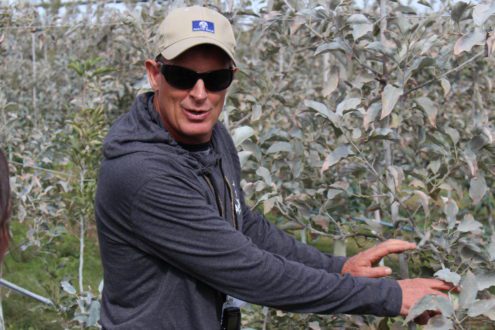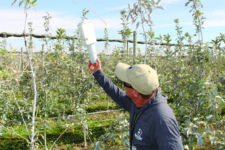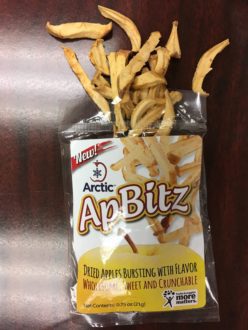

Nov 28, 2018Arctic apple engineers welcome scrutiny, growers’ help
In a hotel conference room in eastern Washington, Okanagan Specialty Fruits employee Jessica Brady takes two apparently identical yellow apples – one in each hand – kneels, and smashes them into the ground.
A thin slice off each, and half an hour’s time later show the difference between the two apples: The flesh of one, a traditional Golden Delicious, is turning brown due to the bruising and cut. The flesh of the other, an Arctic Golden, is still frosty white.
That’s the uncanny, genetically-engineered magic of an Arctic apple, which – its owners say – could boost sales of fresh-cut U.S. apples and thus the total U.S. consumption.
But even as Okanagan Specialty Fruits (OSF) moves ahead with ambitious plans to grow its operations it’s doing so with a dedication to transparency.
In the first week of October, the company brought 10 writers, influencers and trade journalists to eastern Washington state. On the trip, Okanogan detailed plans to put in hundreds of acres of orchards, opened the door to contracting with independent growers to raise OSF-owned trees and fruit, and explained the technology behind its products.


Good growing
OSF was founded by a Canadian in 1996, remains based in Canada, and the headquarters of Intrexon, its parent company since 2015 are in Blacksburg, Virginia. But all of its commercial Arctic apple trees are in eastern Washington state.
The group planted 15 acres of orchards in spring 2015 just after the apples were deregulated. Now, the company has 600 acres in the ground and plans to plant another 800 acres during 2019.
On an afternoon in early October, OSF founder and President Neal Carter leads a tour through an orchard of Arctic Goldens – Golden Delicious apples with the patented genetic trait of non-browning.
Carter has a long, international career as a bioresource engineer and is involved in at least one other company besides Okanagan, but says he is an orchardist at heart.
“I like to grow things,” he says. “If I could spend all of my attention, I’d spend it on the orchard.”
The Arctic Goldens he’s walking through have a super-spindle tree architecture on B.9, M.9 and N.29 rootstocks; Carter says he has just a few on the more expensive Geneva rootstocks.
He says on blocks where they are trying to boost production, they have trained the trees with a bi-axis system.
The orchard has a sturdy trellis system and a $12,000-per-acre netting system overhead to protect from sun damage and hail. Carter says he favors the nets not only for the crop protection but because he says it lessens the need for cooling overhead irrigation, and thus fewer fungicide sprays. In the interest of full disclosure, he adds that he also owns Farm Solutions, the company that produces the nets in Washington as well as Australia and New Zeeland.


It’s a high-tech orchard, with Semios-brand sensors in the tree canopies measuring what the trees are going through and suggesting various orchard actions to substations networked with Internet-enabled towers. A pheromone dispenser – for disrupting the breeding habits of pests – hangs from a trellis with an actuator that’s linked into the Semios system. Drip irrigation is linked into a separate software system – Carter said he can control both systems from a phone or tablet.
Arctic Grannys, Arctic’s copyrighted version of the Granny Smith, are still on the tree. At a shed near where the visiting group eats lunch, employees Edgar Mejia and Angela Flores are testing the apple starches to see if they’re ready for picking. Carter says that most non-Arctic Grannys are picked when labor is available, rather than at the peak condition – a good Granny should show a little blush along with the green.


Welcoming growers
The tour seems designed to show that Carter and Okanagan know how to grow apples. But going forward, Carter said, the company plans to work with large growers in eastern Washington, eastern North America and in the Southern Hemisphere including Argentina, to grow 100 acres or more of OSF-owned trees and fruit. The Arctic genetics and varieties are patented, and the process of working with OSF would be covered under a contracted grower agreement.
“There’s a lot of grower interest, and I think the growers are interested in, ‘How much is this going to pay me?’” Carter said. “They have a business to run.”
Okanagan needs to be able to tell growers how much the company is willing to pay per pound of well-raised apples – a price he estimates as “in the neighborhood of better than the conventional equivalent.”
“Maybe not as much as a club variety,” he adds. “But (Arctic is) also easier to grow and we’re less demanding in terms of what they deliver to the warehouse.” Because the apples don’t brown from bruises, cull percentages are lower – their recent crop of Arctic Goldens had only 2-3 percent damage, including sunburn and bird pecks – well below averages.
“Growers know that and are motivated by that,” he said after the tour.
But he said the reaction from the rest of the industry has not been enthusiastic. He described the typical response as “We wish you well – it’s pretty cool, and if it works, we’ll plant some of these.”


Market matters
OSF Vice President Jennifer Armen was frank about the responses the company has received from the industry.
“Early on we got, ‘Who the hell wants a non-browning apple?’” she said. “When we sit down and talk through the benefits of a non-browning apple, and point to losses along the food chain, people begin to get it.”
Carter has been working on the Arctic product for more than 20 years but in recent years has seen some competing apples come to market.
“When you look back in the marketing world of apples, there wasn’t a non-browning, or a slow-browning, or a low-browning claim to be seen until about five years ago, and now there are several apples that claim low browning, slow browning, anti-browning,” Armen said. “And you know what they say about imitation.”
Arctic’s detractors say other apples do have non-browning traits and point out that treatments such as lemon juice help avoid browning in apple processing.
Carter questioned how well the additives worked. “The solution so far has been to dip slices in things that make it not taste like an apple anymore,” he said.
Armen said a new apple variety made for processing could grow the total amount of produce sold, similar to how baby-cut carrots and packaged salads have boosted vegetable sales in recent years. The packaged lettuce of the 1990s is not the packaged lettuce of the 2010s, she said.
“Like the carrot industry, and the lettuce industry … we developed totally new varieties,” she said.


“There are lots and lots of ways that non-browning apples can contribute to increased apple consumption, and that’s really what we’re about,” Armen said. An Arctic Fuji received USDA approval in 2016, giving the company a red apple to add to the Goldens and green Grannys.
While Okanagan has plans to sell whole Goldens and Grannys over Amazon.com, the company’s niche going forward is in fresh-cut apples which can be cut and packaged before shipping to retailers without browning. So far, Okanagan has been selling dehydrated apple strings, called ApBitz, which look curiously like french fries.


Telling transparency
Genetically engineered food and genetically modified organisms do encounter skepticism with consumers and other gatekeepers in the food industry.
Carter said the company has always been committed to transparency and trying to educate gatekeepers in the industry about the value of its products.
Brady, the apple smasher, led tour attendees in an activity where the group separated DNA strands out of a strawberry puree. She also gave a presentation on how Arctic apples work. In most apples, the enzyme polyphenol oxidase (PPO) reacts with the fruit’s phenols whenever cells are bruised, crunched or cut. The reaction leaves behind a brown melanin. In Arctic apples, the gene that produces PPO has been muted (Arctic apples don’t mask browning caused by rot).
But for many consumers and gatekeepers, accepting genetically engineered products doesn’t come as easy as a science center lecture. A 2016 study by the Pew Research Center showed 39 percent of Americans thought genetically modified foods were worse for one’s health than traditional foods. A smaller percentage are more passionate about the issue. The tour attendees watched a film together showing activists opposed to genetically modified foods holding protests and in once case cutting down test plants in Britain.
“Activists can be an annoyance, and activists get the headlines,” Armen said.
On the other hand, she said that genetically engineered potatoes have been sold for some time.
“They’ve been in the marketplace for four years now and have had maybe a dozen phone calls, never had a protest at a retail location even though they were prepared for it,” she said. “So, while I think we’re aware, we’re cautiously optimistic.”
– FGN Associate Editor Stephen Kloosterman














